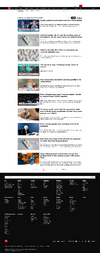In the proposed search area, Terentyev's group found this boiler and more than one. All the "artifacts" found are completely mysterious structures ranging in size from six to nine meters in diameter, made of a metal similar in color to copper unknown to the search group. But these "copper boilers were not taken" even by a sharpened chisel, which "explored" the walls of the taiga engineering product more than once. The metal did not break off and was not forged. According to the researchers, the hammer would have left noticeable dents or cuts on the copper. But the boilers remained intact even after active "research attacks" on their integrity. The whole point was that this "copper" on top was as if covered with another layer of an unknown material, similar to sandpaper. But it was neither an oxide film nor a scale. It was also impossible to chip or scratch it. As noted in her reports, the vegetation around these "boilers" is abnormal - it does not look at all like what grows around. It is more lush: large-leaved burdocks, very long vines, strange grass, one and a half to two times taller than a human. Scientists have thoroughly investigated their mysterious find.
Wow! A real Roadside Picnic!

Roadside Picnic - Wikipedia
Roadside Picnic is set in the aftermath of an extraterrestrial event called the Visitation that took place in several locations around the Earth, simultaneously, over a two-day period. Neither the Visitors themselves nor their means of arrival or departure were ever seen by the local populations who lived inside the relatively small areas, each a few square kilometers, of the six Visitation Zones. The zones exhibit strange and dangerous phenomena not understood by humans, and contain artifacts with inexplicable properties. The title of the novel derives from an analogy proposed by the character Dr. Valentine Pilman, who compares the Visitation to a picnic:
A picnic. Picture a forest, a country road, a meadow. Cars drive off the country road into the meadow, a group of young people get out carrying bottles, baskets of food, transistor radios, and cameras. They light fires, pitch tents, turn on the music. In the morning they leave. The animals, birds, and insects that watched in horror through the long night creep out from their hiding places. And what do they see? Old spark plugs and old filters strewn around... Rags, burnt-out bulbs, and a monkey wrench left behind... And of course, the usual mess—apple cores, candy wrappers, charred remains of the campfire, cans, bottles, somebody’s handkerchief, somebody’s penknife, torn newspapers, coins, faded flowers picked in another meadow.
In this analogy, the nervous animals are the humans who venture forth after the Visitors have left, discovering items and anomalies that are ordinary to those who have discarded them, but incomprehensible or deadly to the earthlings.
This explanation implies that the Visitors may not have paid any attention to, or even noticed, the human inhabitants of the planet during their visit, just as humans do not notice or pay attention to grasshoppers or ladybugs during a picnic. The artifacts and phenomena left behind by the Visitors in the Zones were garbage, discarded and forgotten, without any intentions to advance or damage humanity. There is little chance that the Visitors will return again because for them it was a brief stop, for reasons unknown, on the way to their actual destination.




